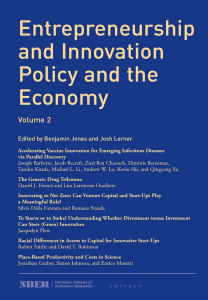On the train this week I read a slim NBER volume, Entrepreneurship, Innovation Policy and the Economy edited by Benjamin Jones and Josh Lerner. There are some interesting papers covering pharmaceuticals innovation, green innovation and distributional issues – specifically, race and place.
The first paper makes a strong case for government support for new vaccine development as the combination of a low probability of any single vaccine being needed and the cost of clinical trials make it impossible for a commercial case to stack up. (It does not tackle the question of why and whether trials need to be so long and costly.) Therefore something like advance purchase commitments are needed. The second paper sets out a trilemma between low price, sufficient quantity and adequate quality including safety for off-patent drugs. Written by US lawyers, it implies the real problem is the unwillingness of the authorities to let generic producers charge enough for their products; absent too low a price cap, quantity and quality can both be assured.
On green tech, one paper looks at the role of venture capitalists in financing science-based rather than incremental innovations as (as Will Baumol also described in The Free Market Innovation Machine) big companies do small innovations and small companies do big innovations, for the most part. The second paper argues for continuing to invest in ‘dirty’ companies to exercise ‘voice’ – Hirschman’s insight pops up everywhere these days.
The final papers find, respectively, that there is a clear racial gradient in access to capital for innovation; and that the benefits of spatial agglomeration outweigh the costs of congestion and by a large margin on average, but by a zero margin in the most R&D concentrated cities such as San Francisco/Silicon Valley.
All very nice papers, of interest to people studying innovation. Almost entirely US-focused however.

